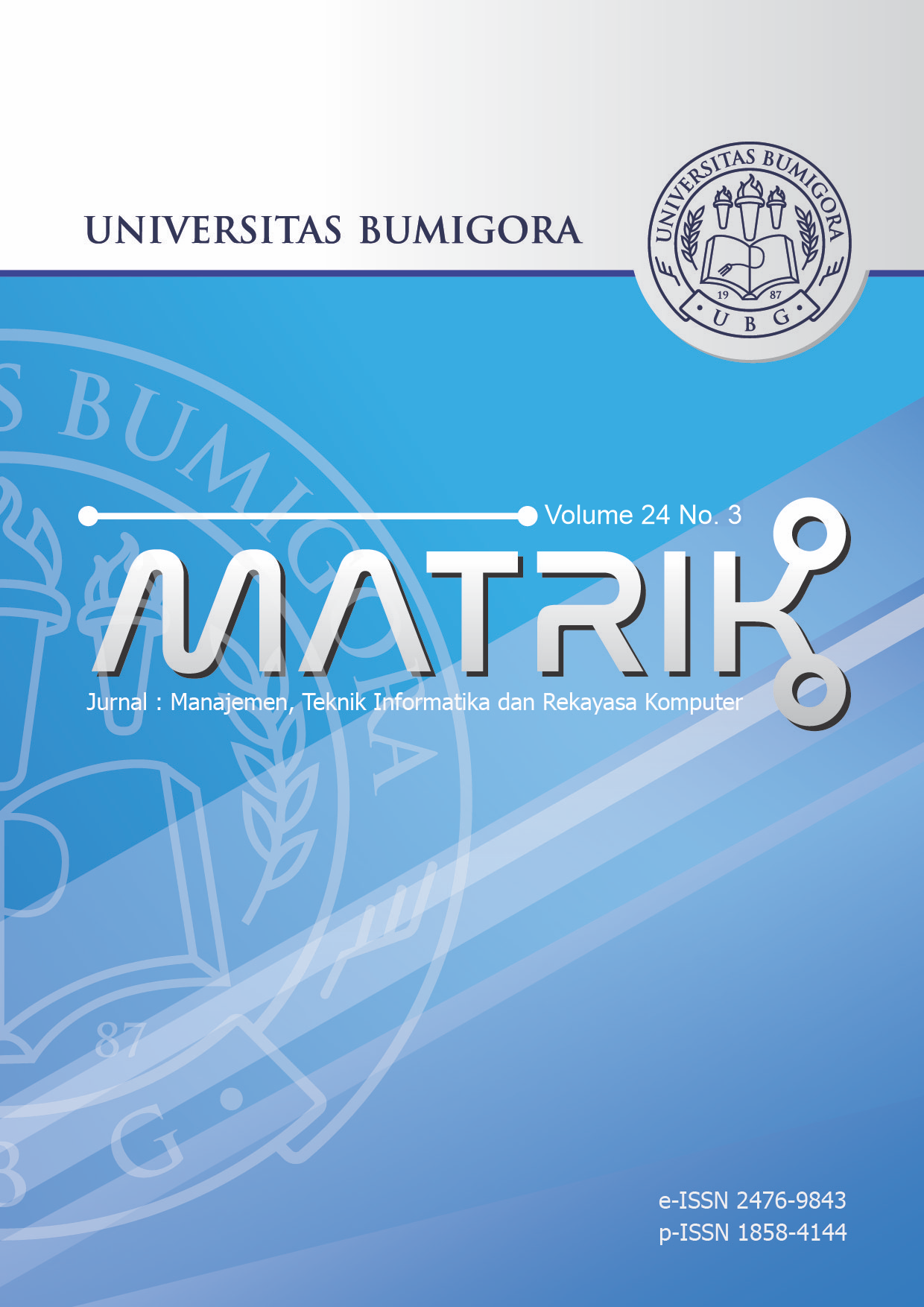Comparison of Random Forest Support Vector Machine and Passive Aggressive Models on E-nose-Based Aromatic Rice Classification
DOI:
https://doi.org/10.30812/matrik.v24i3.4291Keywords:
Aromatic Rice, Electronic Nose, Passive Aggressive, Random Forest, Support Vector MachineAbstract
Accurate classification of aromatic rice types is crucial for maintaining quality and meeting consumer preferences. The purpose of this study is to classify MentikWangi, PandanWangi, and C4 rice based on their volatile content using e-nose. C4 rice, as a popular non-aromatic variety, was included as a comparison for sensor response analysis. The research method involved preprocessing the e-nose gas sensor readings, including feature extraction, baseline manipulation, and missing value checking, to ensure data quality. The classification was performed using Random Forest, Support Vector Machine, and Passive-Aggressive methods. The results showed that the Random Forest model achieved the highest accuracy of 97%, followed by the Support Vector Machine at 95% and Passive Aggressive at 90%. The model evaluation utilized a Confusion Matrix and Receiver Operating Characteristics, which confirmed that Random Forest was the best-performing model. This study concludes that e-nose-based classification effectively differentiates between aromatic rice types, providing significant potential for objective and efficient quality assessment and offering valuable insights for further research in areas such as food technology, agricultural science, and chemical analysis.
Downloads
References
[1] Y. Xiong, X. Zheng, X. Tian, C. Wang, J. Chen, L. Zhou, D. Xu, J. Wang, V. Gilard, M. Wu, and A. You, “Comparative study
of volatile organic compound profiles in aromatic and non-aromatic rice cultivars using HS-GC–IMS and their correlation with
sensory evaluation,” LWT, vol. 203, july, p. 116321, 2024, https://doi.org/10.1016/j.lwt.2024.116321.
[2] A. Akwero, D. Ocan, W. Akech, J. Lamo, M. Ochwo-Ssemakula, and P. Rubaihayo, “Allelic variations in aroma gene in
cultivated rice varieties,” African Crop Science Journal, vol. 28, no. 2, pp. 241–254, Jul. 2020, https://doi.org/10.4314/acsj.
v28i2.9.
[3] X. Lu, X. Cai, and S. Liu, “Application of practical bionic electronic nose in rice wine detection,” in 2ND International
Conference on Frontiers Of Biological Sciences and Engineering (FSBE 2019), Jinan City, China, 2020, p. 020035,
https://doi.org/10.1063/5.0000313.
[4] A. J. Moshayedi, A. Sohail Khan, J. Hu, A. Nawaz, and J. Zhu, “E-Nose-Driven Advancements in Ammonia Gas Detection:
A Comprehensive Review from Traditional to Cutting-Edge Systems in Indoor to Outdoor Agriculture,” Sustainability, vol. 15,
no. 15, p. 11601, july 2023, https://doi.org/10.3390/su151511601.
[5] E. Kartikadarma, S. Wijayanti, S. A. Wulandari, and F. A. Rafrastara, “Principle Component Analysis for Classification of the
Quality of Aromatic Rice,” september 2020, https://doi.org/10.48550/arXiv.2009.06496.
[6] Z. Ye, Y. Liu, and Q. Li, “Recent Progress in Smart Electronic Nose Technologies Enabled with Machine Learning Methods,”
Sensors, vol. 21, no. 22, p. 7620, november 2021, https://doi.org/10.3390/s21227620.
[7] R. Ruslan, S. Khairunniza-Bejo, I. Rukunudin, M. Jahari, and M. Ibrahim, “Development of a machine vision system for rice
seed inspection system,” Food Research, vol. 4, no. S6, pp. 150–156, Dec. 2020, https://doi.org/10.26656/fr.2017.4(S6).049.
[8] A. Aznan, C. Gonzalez Viejo, A. Pang, and S. Fuentes, “Rapid Assessment of Rice Quality Traits Using Low-Cost Digital
Technologies,” Foods, vol. 11, no. 9, p. 1181, Apr. 2022, https://doi.org/10.3390/foods11091181.
[9] A. A. Munawar and Z. Sabaruddin, “Fast classification of rice (Oryza sativa) cultivars based on fragrance and environmental
origins by means of near infrared spectroscopy,” IOP Conference Series: Earth and Environmental Science, vol. 644, no. 1, p.
012003, january 2021, https://doi.org/10.1088/1755-1315/644/1/012003.
[10] M. H. Alsharif, A. H. Kelechi, K. Yahya, and S. A. Chaudhry, “Machine Learning Algorithms for Smart Data Analysis in
Internet of Things Environment: Taxonomies and Research Trends,” Symmetry, vol. 12, no. 1, p. 88, Jan. 2020, https://doi.org/
10.3390/sym12010088.
[11] N. A. Isaac, I. Pikaar, and G. Biskos, “Metal oxide semiconducting nanomaterials for air quality gas sensors: operating principles,
performance, and synthesis techniques,” Microchimica Acta, vol. 189, no. 5, p. 196, 2022, https://doi.org/10.1007/
s00604-022-05254-0.
[12] B. Sumanto, D. R. Java, W. Wijaya, and J. Hendry, “Seleksi Fitur Terhadap Performa Kinerja Sistem E-Nose untuk Klasifikasi
Aroma Kopi Gayo,” MATRIK : Jurnal Manajemen, Teknik Informatika dan Rekayasa Komputer, vol. 21, no. 2, pp. 429–438,
march 2022, https://doi.org/10.30812/matrik.v21i2.1495.
[13] S. Dhanekar, “Smart and Intelligent E-nose for Sensitive and Selective Chemical Sensing Applications,” in Smart Sensors for
Environmental and Medical Applications, 1st ed., H. Hallil and H. Heidari, Eds. Wiley, april 2020, pp. 149–171, https:
//doi.org/10.1002/9781119587422.ch8.
[14] E. S. A. Nugraha, N. D. Resty, Y. I. T. Wijaya, and B. Sumanto, “Electronic Nose to Classify Tobacco Origin using a Naive
Bayes Method based on Feature Selection,” in 2023 International Conference on Computer Science, Information Technology
and Engineering (ICCoSITE). Jakarta, Indonesia: IEEE, february 2023, pp. 267–272, https://doi.org/10.1109/ICCoSITE57641.
2023.10127800.
[15] D. R. Prehanto, A. D. Indriyanti, I. K. D. Nuryana, and G. S. Permadi, “Classification based on K-Nearest Neighbor and Logistic
Regression method of coffee using Electronic Nose,” IOP Conference Series: Materials Science and Engineering, vol. 1098,
no. 3, p. 032080, march 2021, https://doi.org/10.1088/1757-899X/1098/3/032080.
[16] S. Wakhid, R. Sarno, S. I. Sabilla, and D. B. Maghfira, “Detection and Classification of Indonesian Civet and Non-Civet Coffee
Based on Statistical Analysis Comparison Using E-Nose,” International Journal of Intelligent Engineering and Systems, vol. 13,
no. 4, pp. 56–65, augustus 2020, https://doi.org/10.22266/ijies2020.0831.06.
[17] S. Tangirala, “Evaluating the Impact of GINI Index and Information Gain on Classification using Decision Tree Classifier
Algorithm*,” International Journal of Advanced Computer Science and Applications, vol. 11, no. 2, pp. 612–619, 2020, https:
//doi.org/10.14569/IJACSA.2020.0110277.
[18] N. Kunhare, R. Tiwari, and J. Dhar, “Particle swarm optimization and feature selection for intrusion detection system,” S¯adhan¯a,
vol. 45, no. 1, p. 109, december 2020, https://doi.org/10.1007/s12046-020-1308-5.
[19] X. Kan and T. Li, “Slant Split Criterion Random Forests Classification Algorithm based on Soft Margin Hyperplane,” in 2020
IEEE 9th Joint International Information Technology and Artificial Intelligence Conference (ITAIC). Chongqing, China: IEEE,
december 2020, pp. 1332–1337, https://doi.org/10.1109/ITAIC49862.2020.9339073.
[20] B. Sumanto, I. Nathasya, W. Wijaya, and J. Hendry, “Aplikasi Electronic Nose Untuk Klasifikasi Kopi Aceh Gayo Berdasarkan
Proses Pasca Panen,” Jurnal Teknologi dan Sistem Komputer, vol. 11, no. 1, 2024, https://doi.org/10.14710/jtsiskom.2023.
14421.
[21] P. Lemberger and I. Panico, “A primer on domain adaptation theory and applications,” ArXiv, no. M1, 2020.
[22] V. Shabani, A. Havolli, A. Maraj, and L. Fetahu, “Fake News Detection using Naive Bayes Classifier and Passive Aggressive
Classifier,” in 2023 12th Mediterranean Conference on Embedded Computing (MECO). Budva, Montenegro: IEEE, june
2023, pp. 1–6, https://doi.org/10.1109/MECO58584.2023.10155036.
[23] R. Muzzammel and A. Raza, “A Support Vector Machine Learning-Based Protection Technique for MT-HVDC Systems,”
Energies, vol. 13, no. 24, p. 6668, december 2020, https://doi.org/10.3390/en13246668.
[24] A. A. H. De Hond, E. W. Steyerberg, and B. Van Calster, “Interpreting area under the receiver operating characteristic curve,”
The Lancet Digital Health, vol. 4, no. 12, pp. e853–e855, december 2022, https://doi.org/10.1016/S2589-7500(22)00188-1.
[25] B. Sumanto, Y. Idianingrum Tw, S. Humaira, R. Lestari Budiani, and M. Arrofiq, “E-nose Application With Chemometrics
for Monitoring Kombucha Tea Fermentation Process,” JST (Jurnal Sains dan Teknologi), vol. 12, no. 1, march 2023, https:
//doi.org/10.23887/jstundiksha.v12i1.50994.
[26] M. Riadi, A. M. Okasa, R. Sjahril, and M. Mahendradatta, “Volatile Compound Analysis of Aromatic Rice Mutant Lines Using
HS-SPME/GC-MS,” Jurnal Bioteknologi & Biosains Indonesia, vol. 9, no. 2, pp. 257–267, 2022.
Downloads
Published
Issue
Section
License
Copyright (c) 2025 Budi Sumanto, Salima Nurrahma

This work is licensed under a Creative Commons Attribution-ShareAlike 4.0 International License.
How to Cite
Similar Articles
- Lusiana Efrizoni, Sarjon Defit, Muhammad Tajuddin, Anthony Anggrawan, Komparasi Ekstraksi Fitur dalam Klasifikasi Teks Multilabel Menggunakan Algoritma Machine Learning , MATRIK : Jurnal Manajemen, Teknik Informatika dan Rekayasa Komputer: Vol. 21 No. 3 (2022)
- Wahyu Styo Pratama, Didik Dwi Prasetya, Triyanna Widyaningtyas, Muhammad Zaki Wiryawan, Lalu Ganda Rady Putra, Tsukasa Hirashima, Performance Evaluation of Artificial Intelligence Models for Classification in Concept Map Quality Assessment , MATRIK : Jurnal Manajemen, Teknik Informatika dan Rekayasa Komputer: Vol. 24 No. 3 (2025)
- Putu Tisna Putra, Anthony Anggrawan, Hairani Hairani, Comparison of Machine Learning Methods for Classifying User Satisfaction Opinions of the PeduliLindungi Application , MATRIK : Jurnal Manajemen, Teknik Informatika dan Rekayasa Komputer: Vol. 22 No. 3 (2023)
- Pardomuan Robinson Sihombing, Istiqomatul Fajriyah Yuliati, Penerapan Metode Machine Learning dalam Klasifikasi Risiko Kejadian Berat Badan Lahir Rendah di Indonesia , MATRIK : Jurnal Manajemen, Teknik Informatika dan Rekayasa Komputer: Vol. 20 No. 2 (2021)
- Reo Wicaksono, Didik Dwi Prasetya, Ilham Ari Elbaith Zaeni, Nadindra Dwi Ariyanta, Tsukasa Hirashima, Machine Learning for Open-ended Concept Map Proposition Assessment: Impact of Length on Accuracy , MATRIK : Jurnal Manajemen, Teknik Informatika dan Rekayasa Komputer: Vol. 25 No. 1 (2025)
- Budi Sumanto, Denting Romantika Java, Wahyu Wijaya, Jans Hendry, Seleksi Fitur Terhadap Performa Kinerja Sistem E-Nose untuk Klasifikasi Aroma Kopi Gayo , MATRIK : Jurnal Manajemen, Teknik Informatika dan Rekayasa Komputer: Vol. 21 No. 2 (2022)
- Ahmad Zein Al Wafi, Febry Putra Rochim, Veda Bezaleel, Investigating Liver Disease Machine Learning Prediction Performancethrough Various Feature Selection Methods , MATRIK : Jurnal Manajemen, Teknik Informatika dan Rekayasa Komputer: Vol. 24 No. 3 (2025)
- Annisa Nurul Puteri, Suryadi Syamsu, Topan Leoni Putra, Andita Dani Achmad, Support Vector Machine for Predicting Candlestick Chart Movement on Foreign Exchange , MATRIK : Jurnal Manajemen, Teknik Informatika dan Rekayasa Komputer: Vol. 22 No. 2 (2023)
- M Safii, Husain Husain, Khairan Marzuki, Support Vector Machine Optimization for Diabetes Prediction Using Grid Search Integrated with SHapley Additive exPlanations , MATRIK : Jurnal Manajemen, Teknik Informatika dan Rekayasa Komputer: Vol. 25 No. 1 (2025)
- Firda Yunita Sari, Maharani sukma Kuntari, Hani Khaulasari, Winda Ari Yati, Comparison of Support Vector Machine Performance with Oversampling and Outlier Handling in Diabetic Disease Detection Classification , MATRIK : Jurnal Manajemen, Teknik Informatika dan Rekayasa Komputer: Vol. 22 No. 3 (2023)
You may also start an advanced similarity search for this article.
Most read articles by the same author(s)
- Budi Sumanto, Denting Romantika Java, Wahyu Wijaya, Jans Hendry, Seleksi Fitur Terhadap Performa Kinerja Sistem E-Nose untuk Klasifikasi Aroma Kopi Gayo , MATRIK : Jurnal Manajemen, Teknik Informatika dan Rekayasa Komputer: Vol. 21 No. 2 (2022)


.png)












